We visited Bath and London in September 2004. The hot springs (120 degF) at Bath had been enjoyed by local people since prehistoric times. They were discovered by the Romans around 65 AD. The Romans, who were not used to getting their hot water for free, knew a good thing when they saw it and built a temple and bath on the site. Sulis, the local goddess responsible for the hot water, became identified as an aspect of Minerva so the town became known as Aquae Sulis with the temple dedicated to Minerva-Sulis. Most of the remaining structure within about a foot of the water level is Roman, including some lead pipes feeding the main rectangular pool that still function. After the Romans left, their buldings collapsed and were built upon by later generations.
The Roman baths were very elaborate including hot, tepid and cold pools. The floors were heated by hypocausts, passages under them, supported by stacked tiles, for air heated by a wood burning furnace (below). The museum on the site displays Roman era coins and other objects thrown in the pool as offerings by bathers seeking the healing properties of the hot mineralized water.

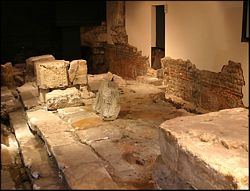
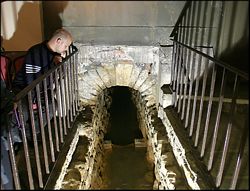
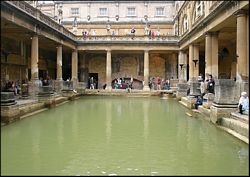



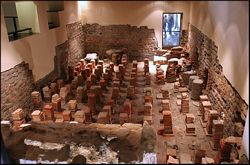
The first church on the abbey site was a Saxon abbey built in 676. It was in this church that Edgar, the first king of all England, was crowned in 973. Construction started on the present Bath Abbey in in 1495 and finished around 1606. The abbey was surrendered to the crown during the dissolution of the monasteries by Henry VIII and left to decay. It was taken over a generation later by the community in Bath as their parish church.
The altar cloth on the high altar is inspired by a biblical passage about flowing water. Other interesting features are the tomb of James Montagu, Bishop of Bath and Wells (1608-1616) and a Garter Knight, and the fan tracery ceiling above the high altar.

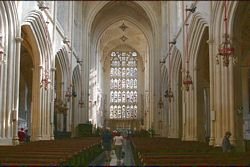
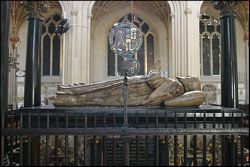



Canterbury was the site of the church established by St. Augustine, the monk sent by Pope Gregory in 597 to convert Britain to Christianity. St Augustine became the first Archbiship of Canterbury and the Archbishops have been the senior bishops of the English church ever since. The present Cathedral was completed in 1077 but has been damaged, rebuilt and added to many times since then.
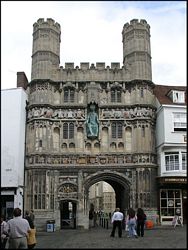


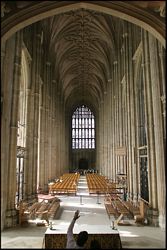

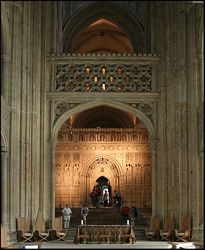
The Christ Church Gate, above, leading into the cathedral precinct, was built in Tudor times. The English have a habit, seen here (l.) and in Westminster Abbey, of building beautiful open spaces under well engineered vaults and arches, then blocking the view by a screen dividing the church into two. Both the wooden screen and the stone arch above it are beautifully carved.
Beyond the screen is the quire and the high altar. In the lower part of the cathedral are the baptismal font and one of several decorated pulpits.

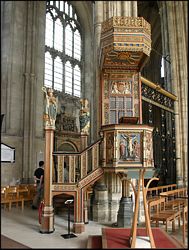
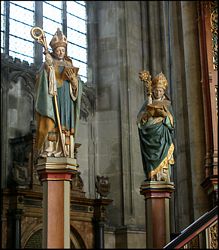

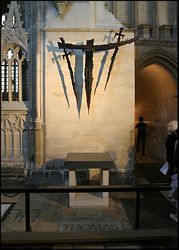
At left is the Altar of the Sword's Point, marking the spot where Thomas Becket was assassinated in 1170. Thomas and Henry II had been involved for years in a complicated dispute about the extent of the royal goverment's control over church assets and people. Henry had originally thought to avoid resistance from the church by appointing his old buddy, Becket, as Archbishop of Canterbury, even though he had never been a priest, but after his appointment, to Henry's surprise and frustration, Becket strongly supported the church's position.
When Henry, in Normandy, heard about Becket's latest act of defiance, he exclaimed how convenient it would be if someone got rid of him, and four of his knights took him literally. Becket was quickly canonized and became the most popular saint in England. With donations from pilgrims, a magnificent shrine was built for Becket behind the high altar. When Cardinal Lorenzo Campeggio, papal nuncio in England to hear the case of Henry VIII's divorce, saw it, he said that "the gold was the cheapest part of it". In 1538, during the dissolution of the monasteries, Henry VIII had the shrine destroyed and confiscated the valuables, the whereabouts of Becket's remains is not known, although there are many legends.
Below are scenes from the upper part of the cathedral, beyond the screen. The stone chair is the "throne of St. Augustine" currently used by the Archbishop of Canterbury. A candle marks the spot where Becket's shrine stood. The tomb is that of Edward, the Black Prince, son of Edward III. He was the adopter of the three feather insignia of the Prince of Wales, which can be seen on the tomb.
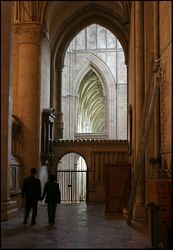
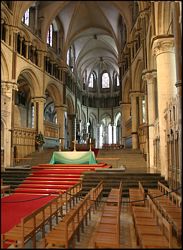
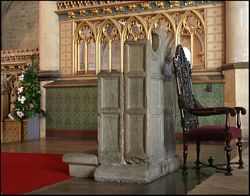

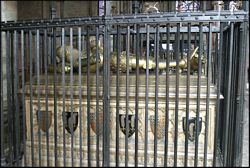
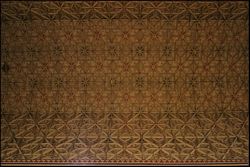
Stonehenge needs no introduction except to mention that the ancient site was much larger than the central plot with the large stones. There was a large circle of wooden or stone pillars along with an avenue leading into the site. Only the traces of the holes remain.
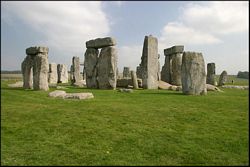

The closest railway station to Stonehenge is Salisbury. Salisbury Cathedral was started in 1220 and finished in 1258. It has the tallest spire in England (404') and the second tallest in Europe, the tour guide pointed out that the tallest, in Germany, was open work and didn't really count. The original Norman cathedral was built in 1092 within the medieval hill fortification of Old Sarum, for this church the community moved to a new site with spacious grounds.
The cathedral library houses one of the four surviving original copies of the Magna Carta (1215), brought there by the Earl of Salisbury, who was the illegitimate half brother of King John. The clock dating from 1386, is claimed to the the oldest operating mechanism in the world. It has no clock face and only strikes the hours.
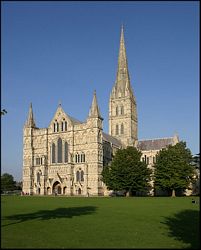

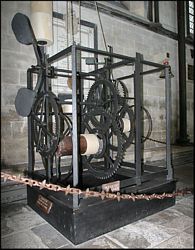
We visited Windsor Castle while in London, but photography was not allowed in the most spectacular parts. We also revisited the Tower or London and the British Museum. The reading room of the British Museum is now open to general visitors.

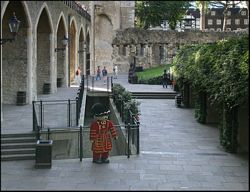
London bridge is now in Arizona, but the Tower Bridge is still in London. Inside the Tower, the Brits make sure a Beefeater is around when a tourist needs one for a photo.
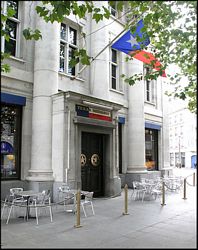
The Texas Embassy is on Pall Mall near the National Gallery. In November 1840, the Republic of Texas and Great Britain signed treaties of mutual recognition and of commerce and navigation. The thrifty Texans appointed Ashbel Smith minister to both Great Britain and France. His first mission was to get both countries to pressure Mexico to recognize and make peace with Texas since Mexico had repudiated Santa Anna's recognition of Texas' independence the day after the battle of San Jacinto.
